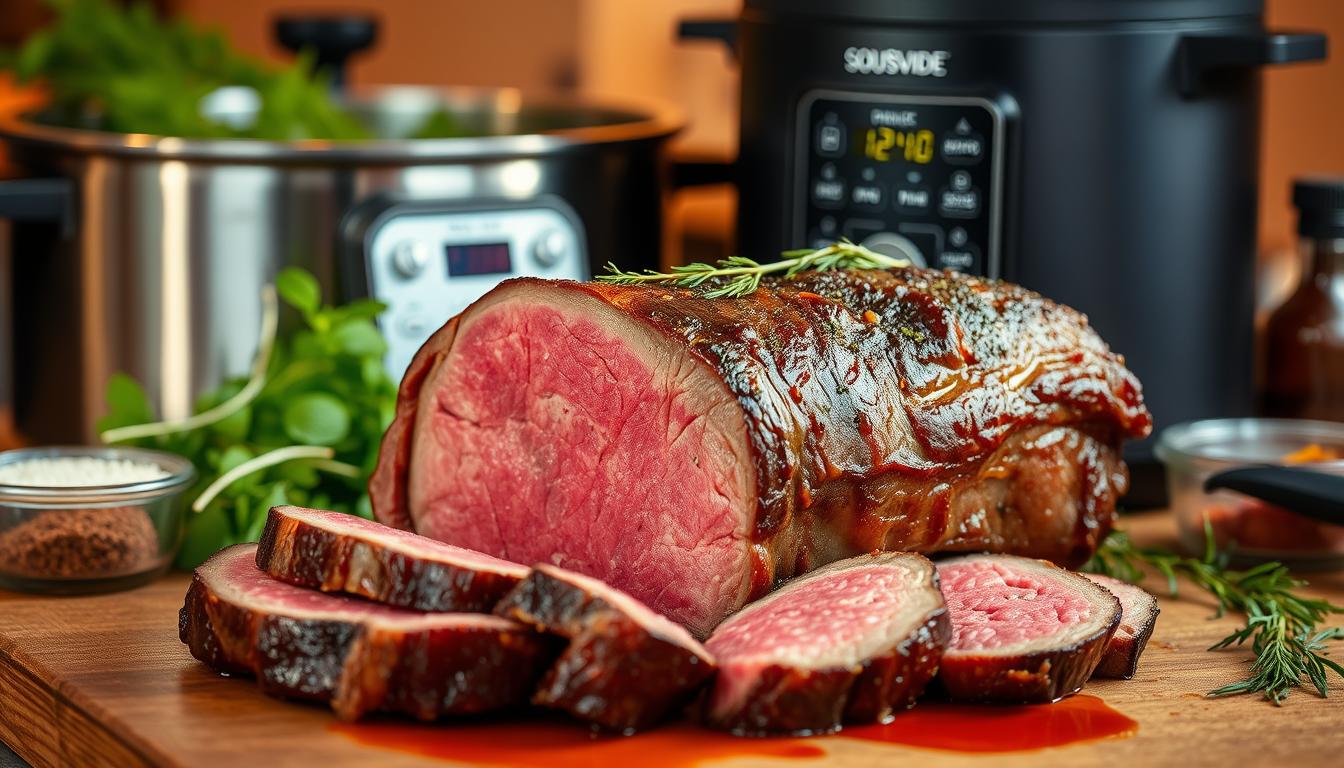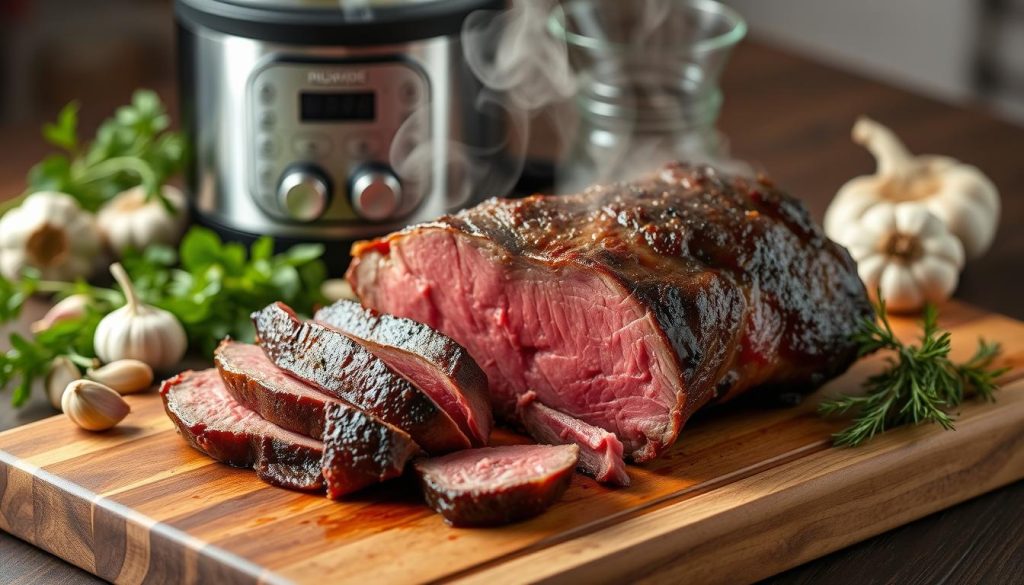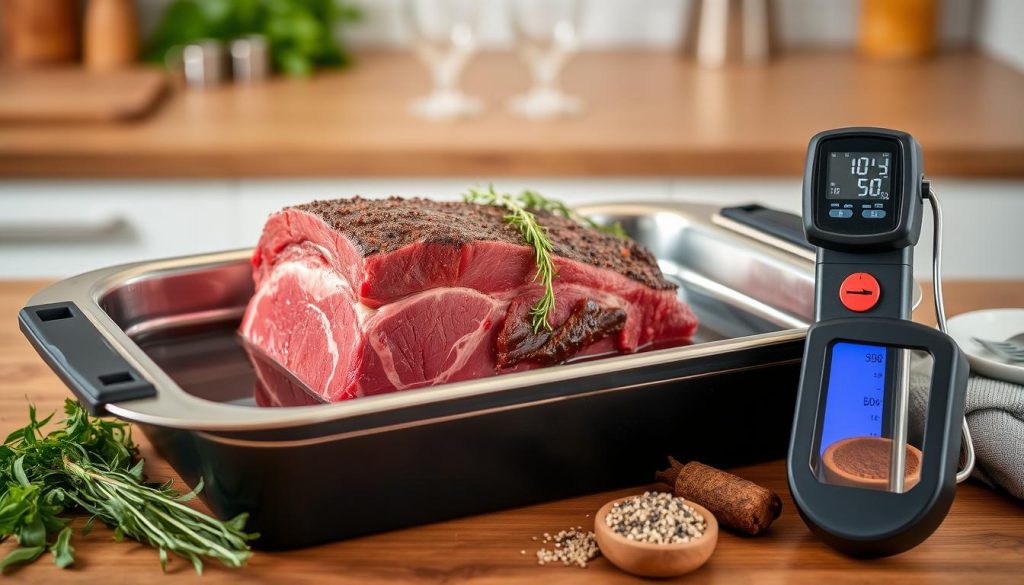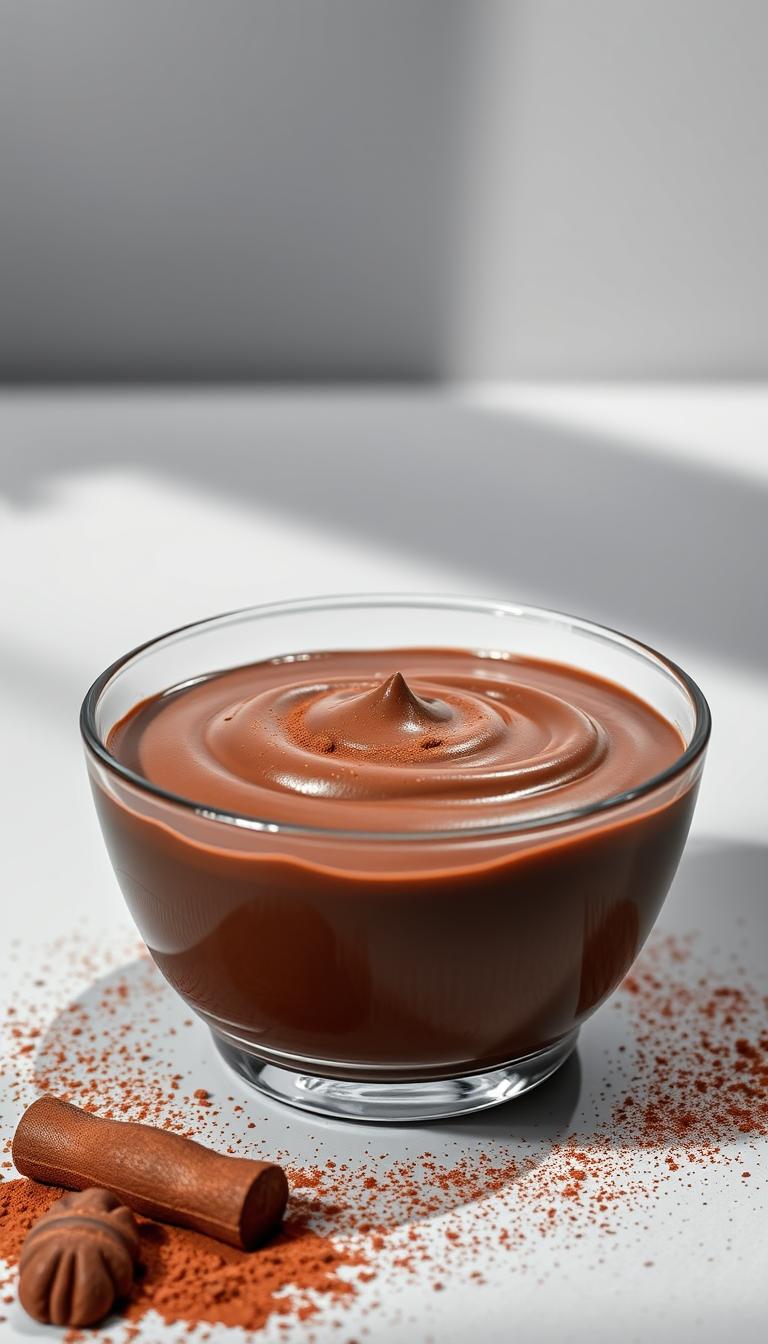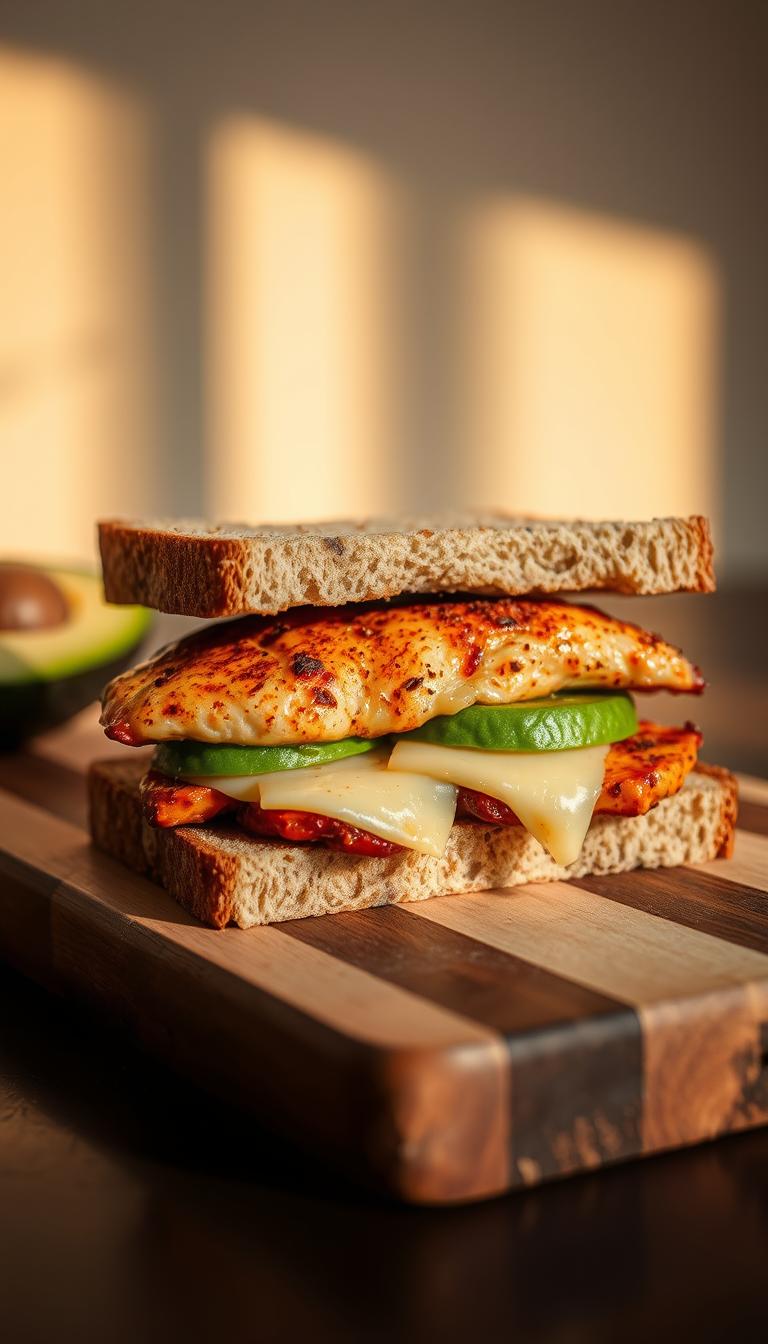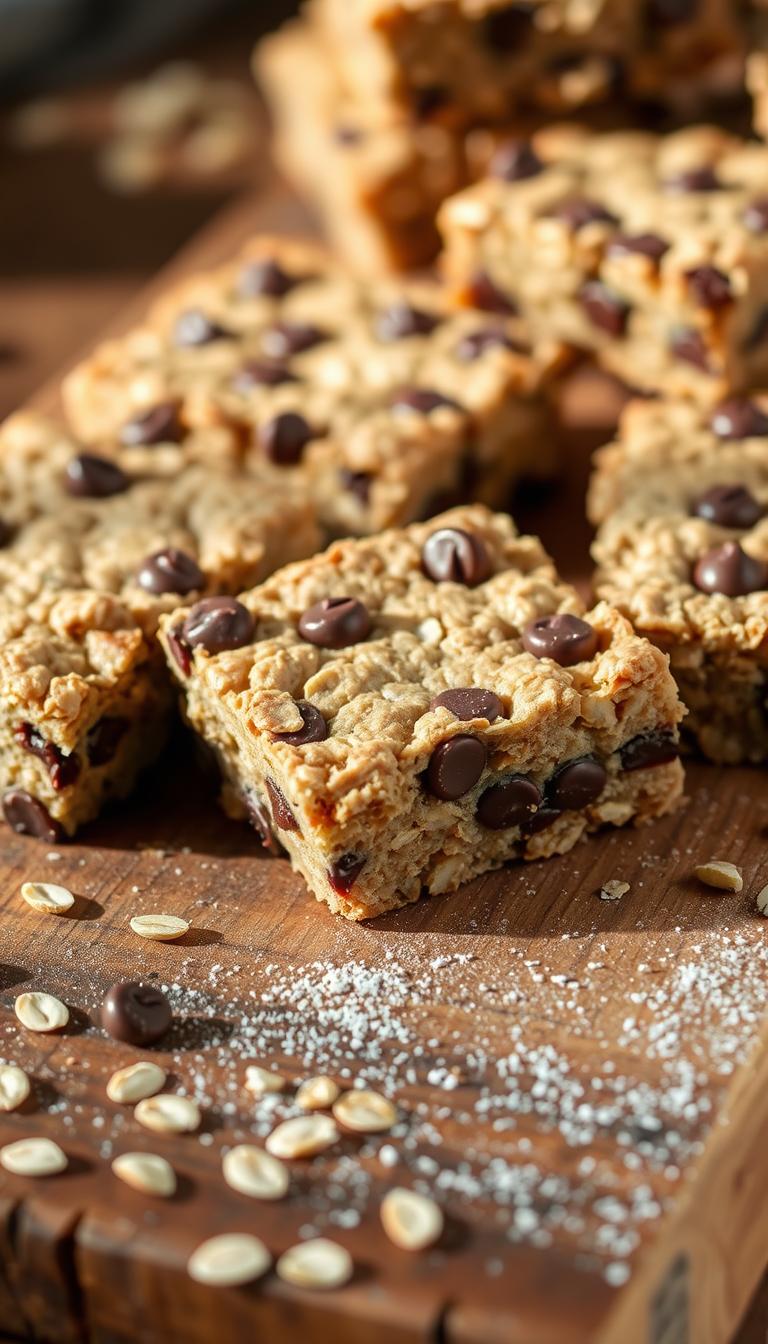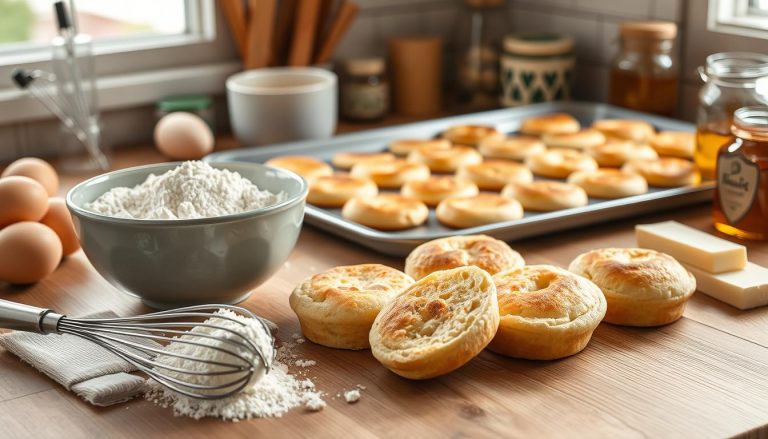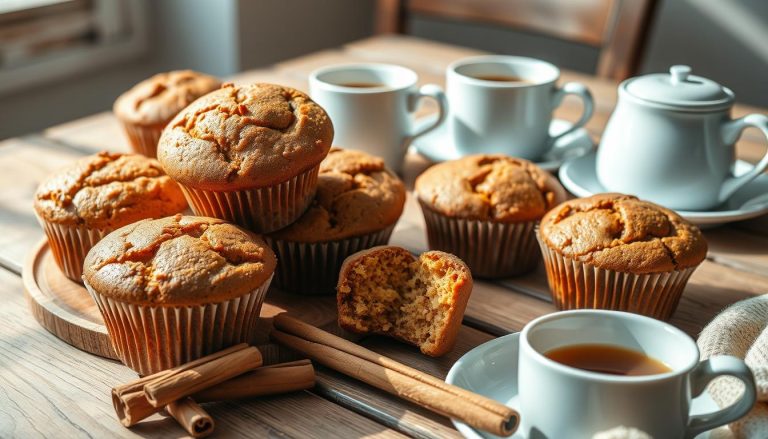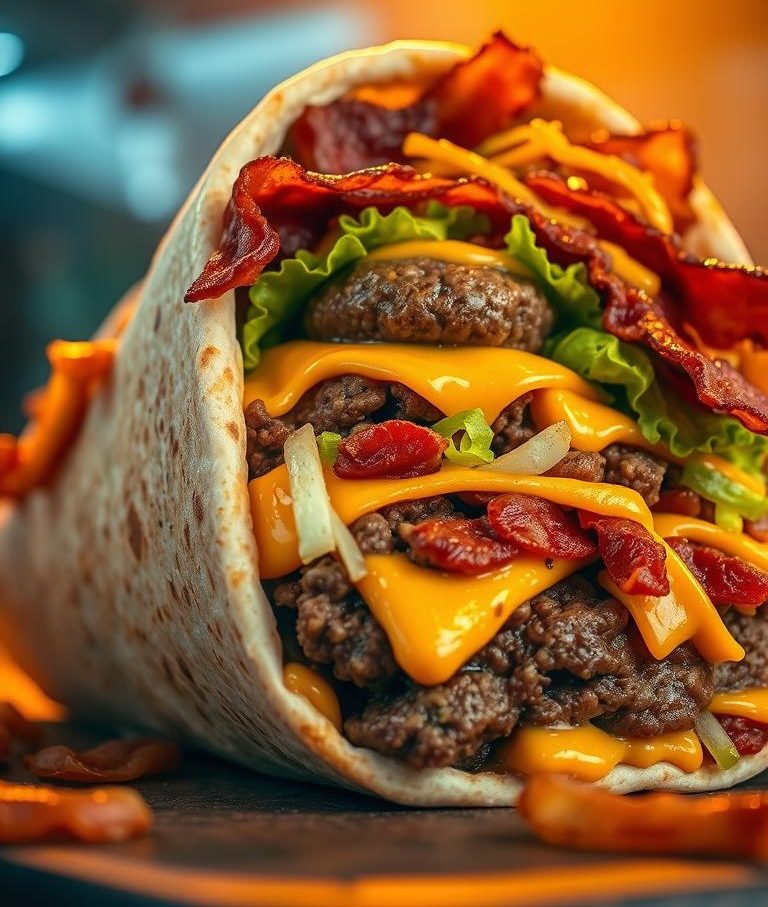The Best Sous Vide Prime Rib: Mouthwatering & Easy to Make
Table of Contents
Every holiday season, I dreaded making the prime rib roast. The fear of overcooking this expensive cut of beef was a big worry. But, when I found sous vide cooking, everything changed.
Prime rib is more than just a meat; it’s the star of the show. Sous vide makes it easy to get amazing flavor and perfect doneness every time. This method is great for both experienced chefs and home cooks.
Imagine a prime rib roast so tender it feels like it’s melting in your mouth. It’s perfectly cooked all the way through, without any dry spots. No more worries about overcooking – just delicious, juicy beef that everyone will love.
Key Takeaways
- Sous vide ensures perfect temperature control for prime rib
- Minimal preparation time with maximum flavor results
- Achievable technique for both professional and home cooks
- Consistent doneness across the entire roast
- Reduces risk of overcooking expensive meat cuts
What is Sous Vide Cooking?
Sous vide cooking has changed how home chefs cook beef tenderloin and make holiday dinners special. This new way of cooking makes sure meat is cooked perfectly every time.
The name “sous vide” comes from French, meaning “under vacuum”. It’s a method where food is sealed in bags and cooked in water at a set temperature.
Understanding the Sous Vide Technique
The technique might seem hard, but it’s really easy. Here’s how it works:
- Seal your meat in a vacuum-sealed or zip-lock bag
- Submerge the bag in a temperature-controlled water bath
- Cook the meat at a consistent temperature for an extended period
Benefits of Sous Vide Cooking
Sous vide has many great benefits for cooking meats like beef tenderloin:
- Precision Cooking: Get the exact doneness every time
- Consistent Results: No risk of overcooking
- Enhanced Flavor Retention: Keeps natural juices and seasonings in
“Sous vide transforms home cooking from guesswork to guaranteed perfection.” – Professional Chef
| Cooking Parameter | Typical Sous Vide Value |
|---|---|
| Cooking Temperature | 132°F-135°F |
| Cooking Duration | 6-8 hours |
| Recommended Meat Cut | Prime Rib |
Learning sous vide will make your holiday dinner amazing. You’ll be able to make meals as good as restaurants, right in your kitchen.
Why Choose Prime Rib for Sous Vide?
Prime rib is a top pick for sous vide cooking. It turns your Christmas or Easter dinner into a feast. This high-quality beef is ideal for precise temperature cooking.
The magic of prime rib is its marbling and texture. Sous vide cooking enhances these qualities. It cooks the meat slowly and evenly.
Flavor and Texture Advantages
Sous vide cooking highlights prime rib’s best features. It offers a unique eating experience. The benefits include:
- Consistent doneness throughout the entire roast
- Enhanced meat tenderness
- Preserved natural juices and flavors
- Precise temperature control
The Ideal Cut for Sous Vide
Prime rib’s fat distribution is perfect for sous vide. The slow cooking melts the fat, making the meat tender and flavorful.
“Sous vide transforms prime rib from good to extraordinary with minimal effort.” – Culinary Expert
Here’s a quick comparison of cooking methods:
| Cooking Method | Tenderness | Flavor Retention | Consistency |
|---|---|---|---|
| Traditional Roasting | Variable | Moderate | Uneven |
| Sous Vide | Exceptional | Maximum | Perfect |
Sous vide cooks prime rib for 18 hours at 136°F. It makes your prime rib the highlight of any special meal, from Christmas to Easter.
Preparing Your Prime Rib
Before starting your sous vide prime rib journey, getting your meat ready is key. You need to pick and prepare it carefully. This ensures a great meal.
Selecting the Perfect Cut
Choose a prime rib with lots of white fat marbling. Aim for a Prime grade cut, about 14 pounds. This will give you 12 servings, with 1 pound for each person.
- Choose meat with consistent white fat marbling
- Look for rich, deep red coloration
- Select cuts with minimal connective tissue
Seasoning and Preparation
Making a garlic herb butter rub is a tasty way to season. Your mix should balance flavors without hiding the meat’s taste. Here’s a good mix:
- ½ cup kosher salt
- 4 tablespoons tri-color peppercorns
- 3 sprigs each of rosemary and thyme
- ½ cup minced garlic
Bringing Meat to Perfect Temperature
Let your prime rib sit at room temperature for 30-60 minutes before cooking. This helps it cook evenly. A meat thermometer is essential for checking the meat’s temperature.
“The secret to a perfect prime rib is patience and precision” – Professional Chef Recommendation
Pro tip: Dry your meat before adding the garlic herb butter. This helps get a great sear and better flavor. Your hard work will pay off with a delicious prime rib that wows everyone.
The Perfect Sous Vide Temperature
To get your prime rib just right, you need to be precise. A meat thermometer is your go-to tool for sous vide cooking. It helps you control the temperature for amazing flavor and texture.
Temperature Classifications for Prime Rib
Knowing the exact temperatures for each doneness level is key to a great meal:
- Rare: 125°F (52°C)
- Medium-Rare: 135°F (57°C) – Most popular choice
- Medium: 145°F (63°C)
- Medium-Well: 150°F (66°C)
- Well-Done: 160°F (71°C)
How Temperature Impacts Flavor
The USDA says roast beef should be cooked to at least 145°F. Sous vide lets you keep the temperature steady, so you get the same result every time. Lower temperatures help keep the meat juicy and tender.
“Precision is the secret to transforming a good prime rib into an extraordinary dining experience.”
With sous vide, you get unmatched control over your prime rib. The steady, low temperature makes the meat tender and full of flavor. It’s a big step up from traditional oven-roasting.
Cooking Time for Sous Vide Prime Rib
Preparing a boneless prime rib recipe for your holiday dinner needs careful attention to cooking time and temperature. Sous vide cooking offers unmatched precision in making the perfect roast.
Factors Influencing Cooking Duration
Several key elements affect the cooking time for your prime rib:
- Roast size and thickness
- Desired level of doneness
- Temperature consistency
- Fat content of the meat
“The magic of sous vide is its ability to deliver consistent, restaurant-quality results every single time.”
General Guidelines for Timing
Your sous vide prime rib cooking time varies based on your specific needs. Here’s a detailed guide:
| Roast Size | Cooking Time | Recommended Temperature |
|---|---|---|
| Small Roast (2-3 lbs) | 6-8 hours | 132°F |
| Medium Roast (4-5 lbs) | 8-10 hours | 135°F |
| Large Roast (5-6 lbs) | 18 hours | 136°F |
For maximum tenderness, keep your prime rib in the enzymatic action zone (between 105°F and 122°F) for at least 5 hours. This method breaks down connective tissues, making your holiday dinner centerpiece incredibly tender.
Pro tip: Always add 4-8 minutes for final searing to get that perfect golden-brown exterior. Your patience will be rewarded with a mouthwatering boneless prime rib recipe that will impress every guest at your holiday dinner.
Vacuum Sealing Your Prime Rib
Getting your prime rib roast ready for sous vide cooking is all about vacuum sealing. This step is key for even heat and keeping water out. It also keeps flavors locked in for a delicious meal.
Essential Equipment for Sealing
To vacuum seal your prime rib, you’ll need a few tools:
- Vacuum sealer machine
- Food-grade vacuum seal bags
- Sharp kitchen scissors
- Clean work surface
Effective Vacuum Sealing Tips
For a perfect seal, pay close attention to detail. Here are some tips for vacuum sealing your prime rib roast:
- Pat the prime rib dry with paper towels before sealing
- Leave enough space at the top of the bag for a proper seal
- Avoid overfilling the bag
- Remove as much air as possible
Garlic Herb Butter Preparation
Boost your prime rib’s taste with garlic herb butter in the bag. Mix softened butter with chopped herbs like thyme and rosemary. Spread it over the meat before sealing for maximum flavor.
“The key to perfect sous vide cooking is a tight, air-free seal that locks in all the delicious flavors.” – Professional Chef
| Vacuum Sealing Method | Pros | Cons |
|---|---|---|
| Vacuum Sealer Machine | Precise, professional results | Higher initial cost |
| Water Displacement Method | Budget-friendly, no special equipment | Less consistent seal |
A good vacuum seal is your secret to a tender, juicy prime rib roast. It’s full of flavor.
The Sous Vide Cooking Process
Mastering sous vide for your boneless prime rib recipe needs precision and patience. This method turns regular meat into a special dish by controlling temperature perfectly.
To start your sous vide prime rib journey, you’ll need a few key tools:
- Sous vide immersion circulator
- Large water-tight container
- Precise meat thermometer
- Vacuum sealer or high-quality zip-lock bags
Setting Up Your Sous Vide Setup
Getting your water bath ready is key for a great boneless prime rib recipe. Fill your container with water and attach the sous vide device. Make sure it keeps a steady temperature. A good meat thermometer helps check the water’s temperature.
Step-by-Step Cooking Instructions
- Fill your container with water
- Set your sous vide device to desired temperature
- Seal your seasoned prime rib in a vacuum-sealed bag
- Carefully lower the bag into the water bath
- Cook for recommended time based on desired doneness
Pro tip: Use a clip to secure the bag to the container’s side, preventing it from floating and ensuring even heat distribution.
Monitoring Your Cooking Process
Keeping a close eye on your cooking is crucial. Check the water level often and make sure the meat thermometer shows a steady temperature. Most sous vide devices have alerts to help you keep the perfect cooking environment for your prime rib.
“Precision is the secret to perfectly cooked meat” – Professional Chef
Finishing Techniques for Enhanced Flavor
Once your sous vide prime rib is perfectly cooked, the final touches can make it truly special. The reverse sear method turns your tender roast into a masterpiece with a delicious crust.
Searing Your Prime Rib to Perfection
Your oven-roasted beef needs a stunning finish. For an amazing sear, use high heat and quick action. You can choose from several methods:
- Cast-iron skillet with high-heat oil
- Blazing hot grill
- Broiler with intense direct heat
When searing, aim for a golden-brown crust. Heat your pan until it’s smoking hot. Then, sear each side for 30-45 seconds. This method seals in flavor and adds a tasty exterior.
The Critical Resting Phase
Resting your prime rib is crucial, not optional. After searing, let it rest for 15-20 minutes. This step allows juices to spread evenly, making each slice tender and flavorful.
“Patience transforms a good roast into an exceptional meal.” – Professional Chef
| Resting Time | Meat Temperature Improvement |
|---|---|
| 15 minutes | 3-5°F increase |
| 20 minutes | 5-7°F increase |
By mastering these finishing techniques, you’ll turn your sous vide prime rib into a dish that rivals restaurant quality. It will surely impress even the most discerning food lovers.
Serving Suggestions and Pairings
Your sous vide prime rib needs amazing side dishes to make your holiday dinner special. With 43 side dish options, you’ll find perfect pairings for your Christmas or Easter dinner. The goal is to find sides that match the meat’s richness and add new flavors and textures.
Potatoes are a top choice, from creamy mashed to crispy roasted. About 50% of recipes add cheese, like cheddar biscuits or cauliflower casserole. Root veggies like carrots and parsnips add a seasonal touch, used in 40% of recipes.
For a fun twist, try sides with crunchy bits like bacon breadcrumbs or crispy onions. About 75% of sides mix veggies and savory elements. Think roasted carrots with honey and herbs or green beans with pomegranate seeds. These combos will wow your guests.
Choose a strong red wine like Cabernet Sauvignon or Bordeaux blends. They match the prime rib’s bold taste. Your sous vide roast and thoughtful sides will make a memorable meal.
FAQ
What is the best temperature for cooking prime rib sous vide?
How long does it take to cook a boneless prime rib using sous vide?
Do I need special equipment to cook prime rib sous vide?
Can I use a garlic herb butter with my prime rib?
What is the reverse sear method, and why is it important?
How do I know when my prime rib is perfectly cooked?
What are the best side dishes for prime rib?
Can I prepare prime rib in advance using sous vide?
Did you try this recipe? Share your thoughts!
There are no reviews yet. Be the first one to write one.

